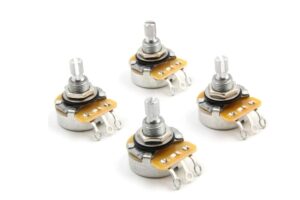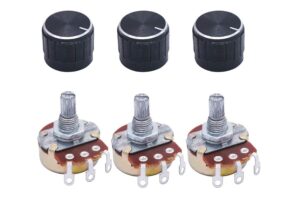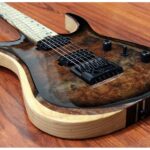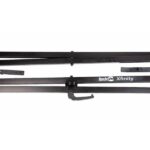Regarding guitar electronics, selecting a suitable potentiometer is crucial for achieving the desired tonal characteristics.

Two common potentiometers used in guitars are audio taper and linear taper.
Each type offers distinct features that can significantly impact your instrument’s overall sound and feel.
Understanding the differences between these two types is vital for you as a guitarist looking to optimize your instrument’s sound.
This article will explore the differences between audio taper and linear taper potentiometers.
We will delve into their characteristics, advantages, and ideal applications to help you understand which one might be the best fit for your guitar.
Contents
Understanding Potentiometers
Potentiometers, also known as pots, are electronic components used in guitar circuits controlling various parameters such as volume and tone.
They are variable resistors that allow for smooth adjustment of these parameters.
Understanding how potentiometers work is significant for guitarists who want to fine-tune their sound.
A potentiometer consists of a rotating shaft and a resistive track. As the shaft is turned, a contact point slides along the resistive track, changing the circuit’s resistance amount.
This change in resistance directly affects the flow of electrical current and, consequently, the guitar’s output signal.
The resistive track of a potentiometer is divided into three terminals. It’s the input terminal, the output terminal, and the wiper terminal.
The input terminal connects to the signal source, while the output terminal connects to an output device, such as an amplifier.
The wiper terminal is the point of contact between the resistive track and the rotating shaft.
By adjusting the position of the wiper terminal along the resistive track, the resistance in the circuit is modified. It results in volume or tone changes.
What is an Audio Taper?
Audio taper is a type of potentiometer designed to provide a logarithmic response to the rotation of the shaft.
If you turn the knob or shaft of an audio taper potentiometer, the resistance changes gradually. It results in a smoother and more natural audio transition.
The term “audio taper” stems from the fact that this potentiometer type is optimized to match how the human ear perceives volume changes.
Our ears have a logarithmic response to sound intensity. It means that we perceive equal increments of loudness as we move up the volume scale.
Audio taper potentiometers mimic this logarithmic response, allowing more precise control over the volume levels.
Advantages of Audio Taper
Audio taper potentiometers offer several advantages, making them a popular choice for guitarists. Here are some benefits of audio taper potentiometers:
Smooth Volume Control
One of the primary advantages of audio taper potentiometers is their ability to provide smooth and gradual volume control. The resistance changes gradually as you turn the knob.
It allows for precise adjustments and more intuitive control over the guitar’s volume.
This smoothness in volume transitions enables musicians to achieve the desired sound dynamics and expressiveness in their playing.
Fine Control in Lower Volume Range
Audio taper potentiometers excel at providing delicate adjustments in the lower volume range.
As the resistance changes gradually at lower volumes, guitarists can achieve subtle tonal nuances.
They can preserve the clarity and detail of their sound even when playing at quieter levels.
It makes audio taper pots ideal for situations where precision and fine control over low-volume tones are desired.
Enhanced Tone Roll-off
When rolling back the volume on an audio taper potentiometer, the tone roll-off is gradual and pleasing to the ear.
The smooth taper allows for a gradual reduction in high frequencies without abrupt changes.
It preserves the clarity and character of the instrument’s tone. This gradual roll-off ensures a more musical and natural transition as the volume decreases.
It allows for seamless tonal variations and dynamic control.
Perception-Matching Design
Audio taper potentiometers are designed to match how the human ear perceives volume changes. Our ears have a logarithmic response to sound intensity.
It means that equal increments of loudness are perceived differently across the volume scale.
Audio taper pots replicate this logarithmic response, providing a volume control that aligns with our natural hearing.
This perception-matching design enhances the overall user experience and allows for more intuitive adjustments.
What is Linear Taper?

Linear taper is a type of potentiometer that provides a linear response to the rotation of the shaft, unlike audio taper potentiometers that have a logarithmic response.
The resistance of a linear taper potentiometer changes at a consistent rate throughout the rotation.
The term “linear” indicates the relationship between the position of the knob and the output signal is linear.
If you turn the knob halfway, the resistance will be between its minimum and maximum values.
Similarly, if you turn the knob one-quarter of the way, the resistance will be one-quarter of its entire range.
Linear taper potentiometers offer a predictable and straightforward response.
It makes them suitable for applications where precise and equal intervals of volume changes are required.
They are commonly used in amplifiers, signal processors, and other equipment that demand consistent and linear control over volume or tone adjustments.
Advantages of Linear Taper
Linear taper potentiometers provide several advantages that make them valuable in specific applications. Here are some benefits of linear taper potentiometers:
Predictable Response
Linear taper potentiometers offer a predictable and straightforward response. The resistance changes at a consistent rate throughout the rotation of the shaft.
It results in a linear relationship between the position of the knob and the output signal. This predictability gives musicians precise control over volume or tone adjustments.
It makes achieving specific settings or desired audio output levels easier.
Suitable for Specific Applications
Linear taper potentiometers are often preferred in applications where precise and equal intervals of volume changes are required.
For example, in certain amplifiers or signal processors, consistent and linear control over volume adjustments is crucial.
Linear taper pots provide the necessary precision to meet such specific needs.
It ensures that volume changes occur at equal increments without any irregularities or unexpected variations.
Cost-Effective Option
Another advantage of linear taper potentiometers is their affordability. Compared to audio taper potentiometers, linear taper pots are generally more cost-effective.
It makes them a favorable choice for musicians working with a budget and not requiring the specialized characteristics of audio taper pots.
Linear taper potentiometers provide reliable and linear control at a more accessible price point.
Comparison Table of Audio Taper and Linear Taper
Both audio taper and linear taper potentiometers have their strengths and best-suited applications. Let’s highlight their differences better:
Features |
Audio Taper |
Linear Taper |
| Response Curve | Logarithmic | Linear |
| Volume Control | Smooth and gradual | Consistent and predictable |
| Lower Volume Range | Delicate adjustments | Equal intervals |
| Tone roll-off | Gradual and pleasing | Consistent and predictable |
| Cost | Relatively more expensive | Cost-effective |
| Popular Use Cases | Guitar volume and tone controls | Amplifiers, signal processors, specific needs |
Choosing the Right Potentiometer
Selecting the suitable potentiometer depends on your preferences, playing style, and the desired tonal characteristics.
If you value smooth volume control and subtle tonal nuances at lower volumes, the audio taper is the best fit.
Or a gradual tone roll-off, audio taper potentiometers are an excellent choice for your guitar.
On the other hand, if you require precise and equal intervals of volume changes, linear may suit your needs.

Or have specific applications where linearity is essential, linear taper potentiometers will serve you well.
Consider experimenting with both types and assessing how they complement your playing style and the sound you aim to achieve.
It’s worth noting that different guitars and pickup configurations can also influence the overall impact of the potentiometer type on your tone.
Conclusion
Choosing between audio taper and linear taper potentiometers can significantly affect how your guitar sounds. It also responds to volume and tone adjustments.
Audio taper pots provide a smooth and gradual response, ideal for nuanced volume control and a pleasing tone roll-off.
Linear taper pots, on the other hand, offer predictable and linear changes. It makes them suitable for specific applications where equal intervals are required.
Selecting the right potentiometer type depends on your preferences, playing style, and the desired tonal characteristics.
It is essential to consider factors such as the specific needs of the guitar, the desired control over volume or tone, and the budget.






